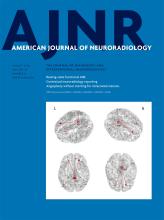Index by author
Chaudhry, A.
- SpineYou have accessDetection of the Stellate and Thoracic Sympathetic Chain Ganglia with High-Resolution 3D-CISS MR ImagingA. Chaudhry, A. Kamali, D.A. Herzka, K.C. Wang, J.A. Carrino and A.M. BlitzAmerican Journal of Neuroradiology August 2018, 39 (8) 1550-1554; DOI: https://doi.org/10.3174/ajnr.A5698
Chen, Y.
- FELLOWS' JOURNAL CLUBInterventionalYou have accessPrimary Angioplasty without Stenting for Symptomatic, High-Grade Intracranial Stenosis with Poor CirculationY. Wang, Y. Ma, P. Gao, Y. Chen, B. Yang and L. JiaoAmerican Journal of Neuroradiology August 2018, 39 (8) 1487-1492; DOI: https://doi.org/10.3174/ajnr.A5708
Thirty-five patients with high-grade, symptomatic intracranial stenosis and poor antegrade flow, treated with intracranial angioplasty without stent placement from January 2010 to December 2016, were retrospectively reviewed. The main outcomes included the changes in antegrade flow and residual stenosis and any stroke or death within 1 month. The average preprocedure stenosis was 88%. The immediate, average postprocedure stenosis rate was 25%, and the average postprocedure stenosis rate at last angiographic follow-up was 35%. The primary end point of major stroke or death at 30 days was observed in 1 patient (1/35, 2.9%), and no patient had intraprocedural complications. The authors conclude that primary balloon angioplasty was an effective treatment option for symptomatic intracranial stenosis with a high risk of stroke.
Choi, C.G.
- Adult BrainOpen AccessClinically Relevant Imaging Features for MGMT Promoter Methylation in Multiple Glioblastoma Studies: A Systematic Review and Meta-AnalysisC.H. Suh, H.S. Kim, S.C. Jung, C.G. Choi and S.J. KimAmerican Journal of Neuroradiology August 2018, 39 (8) 1439-1445; DOI: https://doi.org/10.3174/ajnr.A5711
Choi, S.H.
- Adult BrainOpen AccessApplication of 3D Fast Spin-Echo T1 Black-Blood Imaging in the Diagnosis and Prognostic Prediction of Patients with Leptomeningeal CarcinomatosisJ. Oh, S.H. Choi, E. Lee, D.J. Shin, S.W. Jo, R.-E. Yoo, K.M. Kang, T.J. Yun, J.-h. Kim and C.-H. SohnAmerican Journal of Neuroradiology August 2018, 39 (8) 1453-1459; DOI: https://doi.org/10.3174/ajnr.A5721
Chong, W.K.
- EDITOR'S CHOICEPediatricsYou have accessThe Bone Does Not Predict the Brain in Sturge-Weber SyndromeR.R. Warne, O.M. Carney, G. Wang, D. Bhattacharya, W.K. Chong, S.E. Aylett and K. MankadAmerican Journal of Neuroradiology August 2018, 39 (8) 1543-1549; DOI: https://doi.org/10.3174/ajnr.A5722
MR imaging of 139 children presenting with port-wine stain and/or Sturge-Weber syndrome between 1998 and 2017 was evaluated by 2 pediatric neuroradiologists for marrow signal abnormality and pial angioma and other Sturge-Weber syndrome features. Groups were divided into port-wine stain-only (without intracranial Sturge-Weber syndrome features) and Sturge-Weber syndrome (the presence of cerebral pial angioma). In the port-wine stain-only cohort, 78% had ipsilateral bony changes and 17% had no intraosseous changes. In the Sturge-Weber syndrome cohort, 84/99 had associated port-wine stain, 91% had bony changesipsilateral to the port-wine stain or had no bone changes in the absence of port-wine stain, and 77% had bony changes ipsilateral to a cerebral pial angioma. The authors conclude that intraosseous marrow changes are strongly associated with facial port-wine stain. No significant association was found between pial angioma and bone marrow changes.
Cramer, J.
- SpineYou have accessC1 Posterior Arch Flare Point: A Useful Landmark for Fluoroscopically Guided C1–2 PunctureM.E. Peckham, L.M. Shah, A.C. Tsai, E.P. Quigley, J. Cramer and T.A. HutchinsAmerican Journal of Neuroradiology August 2018, 39 (8) 1562-1567; DOI: https://doi.org/10.3174/ajnr.A5706
Czech, T.
- PediatricsYou have accessAssessing Corticospinal Tract Asymmetry in Unilateral PolymicrogyriaO. Foesleitner, K.-H. Nenning, T. Traub-Weidinger, M. Feucht, S. Bonelli, T. Czech, C. Dorfer, D. Prayer and G. KasprianAmerican Journal of Neuroradiology August 2018, 39 (8) 1530-1535; DOI: https://doi.org/10.3174/ajnr.A5715
Delgado, A.F.
- PediatricsYou have accessArterial Spin-Labeling in Children with Brain Tumor: A Meta-AnalysisA.F. Delgado, F. De Luca, P. Hanagandi, D. van Westen and A.F. DelgadoAmerican Journal of Neuroradiology August 2018, 39 (8) 1536-1542; DOI: https://doi.org/10.3174/ajnr.A5727
- PediatricsYou have accessArterial Spin-Labeling in Children with Brain Tumor: A Meta-AnalysisA.F. Delgado, F. De Luca, P. Hanagandi, D. van Westen and A.F. DelgadoAmerican Journal of Neuroradiology August 2018, 39 (8) 1536-1542; DOI: https://doi.org/10.3174/ajnr.A5727
De Luca, F.
- PediatricsYou have accessArterial Spin-Labeling in Children with Brain Tumor: A Meta-AnalysisA.F. Delgado, F. De Luca, P. Hanagandi, D. van Westen and A.F. DelgadoAmerican Journal of Neuroradiology August 2018, 39 (8) 1536-1542; DOI: https://doi.org/10.3174/ajnr.A5727
Delwail, V.
- FELLOWS' JOURNAL CLUBAdult BrainYou have accessAdded Value of Spectroscopy to Perfusion MRI in the Differential Diagnostic Performance of Common Malignant Brain TumorsA. Vallée, C. Guillevin, M. Wager, V. Delwail, R. Guillevin and J.-N. ValléeAmerican Journal of Neuroradiology August 2018, 39 (8) 1423-1431; DOI: https://doi.org/10.3174/ajnr.A5725
From January 2013 to January 2016, fifty-five consecutive patients with histopathologically proved lymphomas, glioblastomas, and metastases were included in this study after undergoing MR imaging. The perfusion parameters (maximum relative CBV, maximum percentage of signal intensity recovery) and spectroscopic concentration ratios (lactate/Cr, Cho/NAA, Cho/Cr, and lipids/Cr) were analyzed individually and in optimal combinations. The highest differential diagnostic performance was obtained with the following combined classifiers: 1) maximum percentage of signal intensity recovery-Cho/NAA to discriminate lymphomas from glioblastomas and metastases; 2) relative CBV-Cho/NAA to discriminate glioblastomas from lymphomas and metastases; and 3) maximum percentage of signal intensity recovery-lactate/Cr and maximum percentage of signal intensity recovery-Cho/Cr to discriminate metastases from lymphomas and glioblastomas. The authors conclude that spectroscopy yielded an added performance value to perfusion using optimal combined classifiers of these modalities.








